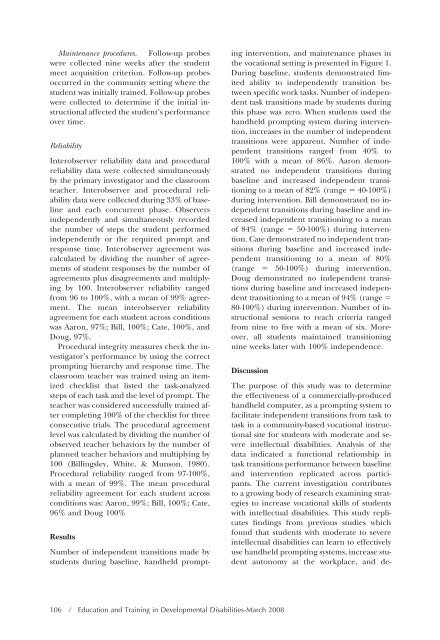Download the Journal (PDF) - Division on Autism and ...
Download the Journal (PDF) - Division on Autism and ...
Download the Journal (PDF) - Division on Autism and ...
Create successful ePaper yourself
Turn your PDF publications into a flip-book with our unique Google optimized e-Paper software.
Maintenance procedures. Follow-up probes<br />
were collected nine weeks after <str<strong>on</strong>g>the</str<strong>on</strong>g> student<br />
meet acquisiti<strong>on</strong> criteri<strong>on</strong>. Follow-up probes<br />
occurred in <str<strong>on</strong>g>the</str<strong>on</strong>g> community setting where <str<strong>on</strong>g>the</str<strong>on</strong>g><br />
student was initially trained. Follow-up probes<br />
were collected to determine if <str<strong>on</strong>g>the</str<strong>on</strong>g> initial instructi<strong>on</strong>al<br />
affected <str<strong>on</strong>g>the</str<strong>on</strong>g> student’s performance<br />
over time.<br />
Reliability<br />
Interobserver reliability data <strong>and</strong> procedural<br />
reliability data were collected simultaneously<br />
by <str<strong>on</strong>g>the</str<strong>on</strong>g> primary investigator <strong>and</strong> <str<strong>on</strong>g>the</str<strong>on</strong>g> classroom<br />
teacher. Interobserver <strong>and</strong> procedural reliability<br />
data were collected during 33% of baseline<br />
<strong>and</strong> each c<strong>on</strong>current phase. Observers<br />
independently <strong>and</strong> simultaneously recorded<br />
<str<strong>on</strong>g>the</str<strong>on</strong>g> number of steps <str<strong>on</strong>g>the</str<strong>on</strong>g> student performed<br />
independently or <str<strong>on</strong>g>the</str<strong>on</strong>g> required prompt <strong>and</strong><br />
resp<strong>on</strong>se time. Interobserver agreement was<br />
calculated by dividing <str<strong>on</strong>g>the</str<strong>on</strong>g> number of agreements<br />
of student resp<strong>on</strong>ses by <str<strong>on</strong>g>the</str<strong>on</strong>g> number of<br />
agreements plus disagreements <strong>and</strong> multiplying<br />
by 100. Interobserver reliability ranged<br />
from 96 to 100%, with a mean of 99% agreement.<br />
The mean interobserver reliability<br />
agreement for each student across c<strong>on</strong>diti<strong>on</strong>s<br />
was Aar<strong>on</strong>, 97%; Bill, 100%; Cate, 100%, <strong>and</strong><br />
Doug, 97%.<br />
Procedural integrity measures check <str<strong>on</strong>g>the</str<strong>on</strong>g> investigator’s<br />
performance by using <str<strong>on</strong>g>the</str<strong>on</strong>g> correct<br />
prompting hierarchy <strong>and</strong> resp<strong>on</strong>se time. The<br />
classroom teacher was trained using an itemized<br />
checklist that listed <str<strong>on</strong>g>the</str<strong>on</strong>g> task-analyzed<br />
steps of each task <strong>and</strong> <str<strong>on</strong>g>the</str<strong>on</strong>g> level of prompt. The<br />
teacher was c<strong>on</strong>sidered successfully trained after<br />
completing 100% of <str<strong>on</strong>g>the</str<strong>on</strong>g> checklist for three<br />
c<strong>on</strong>secutive trials. The procedural agreement<br />
level was calculated by dividing <str<strong>on</strong>g>the</str<strong>on</strong>g> number of<br />
observed teacher behaviors by <str<strong>on</strong>g>the</str<strong>on</strong>g> number of<br />
planned teacher behaviors <strong>and</strong> multiplying by<br />
100 (Billingsley, White, & Muns<strong>on</strong>, 1980).<br />
Procedural reliability ranged from 97-100%,<br />
with a mean of 99%. The mean procedural<br />
reliability agreement for each student across<br />
c<strong>on</strong>diti<strong>on</strong>s was: Aar<strong>on</strong>, 99%; Bill, 100%; Cate,<br />
96% <strong>and</strong> Doug 100%<br />
Results<br />
Number of independent transiti<strong>on</strong>s made by<br />
students during baseline, h<strong>and</strong>held prompt-<br />
ing interventi<strong>on</strong>, <strong>and</strong> maintenance phases in<br />
<str<strong>on</strong>g>the</str<strong>on</strong>g> vocati<strong>on</strong>al setting is presented in Figure 1.<br />
During baseline, students dem<strong>on</strong>strated limited<br />
ability to independently transiti<strong>on</strong> between<br />
specific work tasks. Number of independent<br />
task transiti<strong>on</strong>s made by students during<br />
this phase was zero. When students used <str<strong>on</strong>g>the</str<strong>on</strong>g><br />
h<strong>and</strong>held prompting system during interventi<strong>on</strong>,<br />
increases in <str<strong>on</strong>g>the</str<strong>on</strong>g> number of independent<br />
transiti<strong>on</strong>s were apparent. Number of independent<br />
transiti<strong>on</strong>s ranged from 40% to<br />
100% with a mean of 86%. Aar<strong>on</strong> dem<strong>on</strong>strated<br />
no independent transiti<strong>on</strong>s during<br />
baseline <strong>and</strong> increased independent transiti<strong>on</strong>ing<br />
to a mean of 82% (range 40-100%)<br />
during interventi<strong>on</strong>. Bill dem<strong>on</strong>strated no independent<br />
transiti<strong>on</strong>s during baseline <strong>and</strong> increased<br />
independent transiti<strong>on</strong>ing to a mean<br />
of 84% (range 50-100%) during interventi<strong>on</strong>.<br />
Cate dem<strong>on</strong>strated no independent transiti<strong>on</strong>s<br />
during baseline <strong>and</strong> increased independent<br />
transiti<strong>on</strong>ing to a mean of 80%<br />
(range 50-100%) during interventi<strong>on</strong>.<br />
Doug dem<strong>on</strong>strated no independent transiti<strong>on</strong>s<br />
during baseline <strong>and</strong> increased independent<br />
transiti<strong>on</strong>ing to a mean of 94% (range <br />
80-100%) during interventi<strong>on</strong>. Number of instructi<strong>on</strong>al<br />
sessi<strong>on</strong>s to reach criteria ranged<br />
from nine to five with a mean of six. Moreover,<br />
all students maintained transiti<strong>on</strong>ing<br />
nine weeks later with 100% independence.<br />
Discussi<strong>on</strong><br />
106 / Educati<strong>on</strong> <strong>and</strong> Training in Developmental Disabilities-March 2008<br />
The purpose of this study was to determine<br />
<str<strong>on</strong>g>the</str<strong>on</strong>g> effectiveness of a commercially-produced<br />
h<strong>and</strong>held computer, as a prompting system to<br />
facilitate independent transiti<strong>on</strong>s from task to<br />
task in a community-based vocati<strong>on</strong>al instructi<strong>on</strong>al<br />
site for students with moderate <strong>and</strong> severe<br />
intellectual disabilities. Analysis of <str<strong>on</strong>g>the</str<strong>on</strong>g><br />
data indicated a functi<strong>on</strong>al relati<strong>on</strong>ship in<br />
task transiti<strong>on</strong>s performance between baseline<br />
<strong>and</strong> interventi<strong>on</strong> replicated across participants.<br />
The current investigati<strong>on</strong> c<strong>on</strong>tributes<br />
to a growing body of research examining strategies<br />
to increase vocati<strong>on</strong>al skills of students<br />
with intellectual disabilities. This study replicates<br />
findings from previous studies which<br />
found that students with moderate to severe<br />
intellectual disabilities can learn to effectively<br />
use h<strong>and</strong>held prompting systems, increase student<br />
aut<strong>on</strong>omy at <str<strong>on</strong>g>the</str<strong>on</strong>g> workplace, <strong>and</strong> de-
















